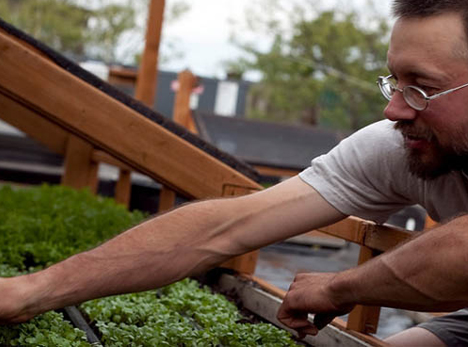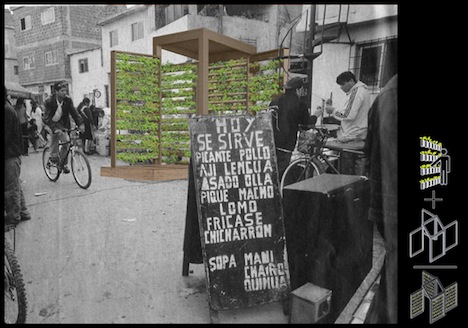Resources
What is Food Urbanism?
Upcoming events
You don't have access to any upcoming eventsSearch
Support

- FUI is supported by a grant from the Swiss National Science Foundation under the National Research Programme NRP 65 "New Urban Quality"
Typology >Toiture végétalisme accessible
Description
Ces toitures plates végétalisées peuvent varier d’utilisation (productive ou récréative) selon différents facteurs tels que l’accessibilité de la toiture au public. La quantité de substrat pouvant être installée sur la toiture joue également un rôle déterminant pour le type de production envisagé sur la toiture et la diversité des espèces installées. Tous ces facteurs conditionnent l’utilisation d’une toiture dans le cadre d’une ferme urbaine sur toit ou d’un jardin public venant compléter la diversité des lieux publics en mettant en scène un point de vue particulier.
Contexte urbain
Ces surfaces viennent, lorsqu’elles sont publiquement accessibles, compléter la palette des espaces urbains. Elles sont utilisées dans la même vague que les parcs et jardins publics. Lorsque leur accès est purement privé, elles n’ont qu’une faible influence sur l’environnement urbain en soit, mais la présence de toitures végétalisées permet de dynamiser le paysage urbain.
Composante environnementale
La végétation d’une toiture aménagée apporte une diversité au niveau de la flore en permettant à des espèces plus fragiles de s’installer sur des surfaces protégées au coeur de la ville, mais également animales en créant des abris pour une microfaune.
Néanmoins, les différentes constructions adjacentes risquent d’ombrager les cultures et ainsi péjorer la productivité des terrains.
Possibilités
Surfaces fortement présentent dans les villes.
Mise en place d’une structure publique possible.
Permet une diversité de culture.
Cultures facilement contrôlables au niveau des imports et conditions pédologiques.
Accessibilité de la surface facilement contrôlable.
Tout changement présente un impact fort pour la population.
Contraintes
L’accessibilité des toitures implique le besoin de sécuriser les bords de la toiture.
Intervention limitée par les capacités techniques.
Sensible à toute dégradation.
Nécessite un entretien constant.
Where do your vegees come from ?

Where do your vegetables come from? In big cities people tend to forget where and how food is produced. The installation was an effort to bring together food consumption and production in a simple direct way. The aim of the …
+ read more
Quartier de la praille, genève

Ce site est appréhendé comme une articulation majeure entre différentes formes et activités urbaines (concentration des grands axes de communication, plate-forme multimodale, quartiers d’affaires, quartiers d’habitations etc.), entre grandes entités paysagères identitaires de la région et espaces urbains genevois.
L’image …
+ read more
Evaluation du potentiel d’aménagement de serres sur les toits à Genève

Ce mandat d’étude en cours, accordé par le service d’agriculture du canton de Genève au groupement pluridisciplinaire Agridea, Agroscope Proficrops et VWA, vise à faire une synthèse des différentes expériences de serres sur les toits et à proposer un concept …
+ read more
Rooftop farming in Romainville

The project is born out of the reclamation of a 60s social housing project and plans to integrate a rooftop greenhouse system that will support urban rooftop farming. The mixed use building allows communities to reduce the distance between food …
+ read more
Center for the Environment

At Catawba College‘s Center for the Environment are developing two urban agriculture initiatives: a green roof for the science building and a new high efficiency greenhouse.
The college is using a high efficiency Suncatcher greenhouse that deals with the problem …
+ read more
Dakakker Urban Rooftop Farm

As part of the 5th International Architecture Biennial Rotterdam, the Rotterdam Test Site has included the city’s first rooftop garden on top of the Schieblock building. The garden houses vegetables. herbs and bees, with the produce being distributed to local …
+ read more
Queen Elizabeth Health Centre Rooftop garden

The container garden is a project of Biotop-AAC, a company set up by Valiquette and the agriculture department to find commercial applications. The garden produced more than 113 kilograms of fresh fruit and vegetables in it’s first year and the …
+ read more
Brooklyn Grange

Brooklyn Grange Farm is a 1-acre rooftop garden on top of a 1919 industrial building in Queens, New York. The Farm is a commercial enterprise, selling produce to restaurants and businesses, as well as directly to the consumer through two …
+ read more
Bastille Restaurant Rooftop Garden

Bastille cafe, like many organic and sustainable restaurants, source their products from local farmers and purveyors whenever possible. However Bastille Cafe has taken this a step further by sourcing vegetables from their own roof. A 4,500 square foot garden of …
+ read more
Gotham Greens

Gotham Greens is a professional hydroponic farm sited on the roof of an old bowling alley. The operation is housed in a $2million greenhouse. The operation uses about 700 gallons of water a day, recycling much of it and using …
+ read more
Sky Vegetables

Sky Vegetables is an entrepreneurial business venture which constructs commercial-scale hydroponic farms on urban rooftops of 10,000 sq ft or more. Their mission is to improve the health and nutrition of city populations and provide new jobs and educational opportunities …
+ read more
Edible Estates #10 – Roma Mangia Roma

In Edible Estates #10, Fritz Haeg has organized a farm on the rooftop of the American Academy in Rome. Using containers sourced from the the building (plastic bottles, paper cartons, cardboard boxes, etc.), and a worm bin turns food scraps …
+ read more
Lufa Prototype Farm

Lufa Farms responds to a desire to have fresh food that does not require a long journey and multiple steps between its growth and consumption in Montreal. The idea is to create a prototype, that can be replicated. However it …
+ read more
Pasona 02

Pasona 02 is a 1 sq. km. farm in the basement of a 27-storey in Tokyo’s business district. Growing more than 100 plants using hydroponics, climate control, and flourescent light reflected by the silver foil paper walls, the farm provides …
+ read more
Eagle Street Rooftop Farms

Eagle Street Rooftop Farm is a large rooftop garden in a dense urban area. The building owners worked with Goode Green to develop and install the base greenroof. Crops are planted in 10 – 15cm of soil and 3 bee …
+ read more
Casa Huerta

Casa Huerta is a group of young professionals from various design fields working to address the health and infrastructural needs of the rapidly urbanizing cities in Brazil. By working with agronomists, the group has developed prototypes of “house and garden” …
+ read more
Curran House

Curran House is a high density affordable housing structure in San Francisco’s Tenderloin neighborhood. There is a garden on the first floor entrance which leads to a courtyard in the back, serving as a “decompression” garden as one moves from …
+ read more
Eli’s Vinegar Factory

Eli’s Vinegar Factory attempts to cut the food miles that the products must take to the shortest distance. Some of the food is grown in a roof greenhouse and trellis garden. The majority is sourced from upstate New York farmers. …
+ read more




